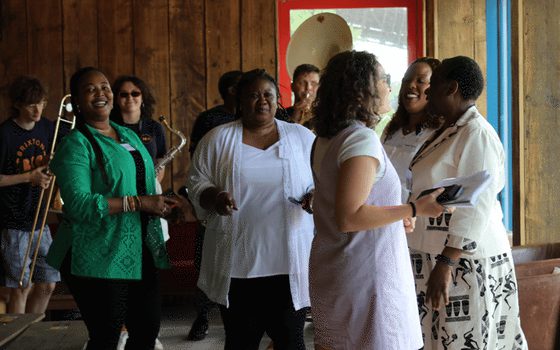At home in the housing movement
When it comes to housing, it’s easy to think that young people are trapped in insecure rented homes while older people are comfortable homeowners. But for disabled people the story doesn’t quite match up.
12 September 2023
This is an article from the sixth issue of the New Economics Zine. You can find the full issue here.
Can you remember the last time you were waiting for something important? The pressure building whilst you wait for an answer?
Every day, up and down the country, Disabled people are waiting to hear back about accessible housing. We might be waiting for our council to tell us if an accessible home is available or for an adaptation to make our homes safer. Often, we are waiting to hear if our benefits will even cover our rent.
When it comes to housing, Disabled people wait years to hear good news. Meanwhile, the UK’s housing system drains our energy, spirit and independence.
Often when we talk about the problems in our housing system, we talk in binaries: young people are stuck renting, while older people have the stability of owning their own home.
But this is not the reality for Disabled people. We are less likely to own our homes across all ages, with the Office for National Statistics (ONS) finding that older Disabled people can be up to 20% less likely to own their homes than their non-disabled peers. Disabled people are far more reliant on social housing rather than homeownership, and our homes rarely suit our needs.
“We aren’t asking for luxuries or vanity items – we are demanding to be provided with the homes to which we have a right.”
For non-disabled people, it can be hard to picture the reality of living in an inaccessible home. We aren’t asking for luxuries or vanity items – we are demanding to be provided with the homes to which we have a right.
Disabled people make up one-fifth of the UK population, yet many outside our circles don’t understand that inaccessible homes are unsafe, may worsen our impairments or health conditions, and directly stop us from living independent, active, fulfilling lives regardless of age.
This lack of understanding has led to a situation where our homes are in dire need of adaptations. These changes are often straightforward, like installing stair-lifts, level-access showers and wet-rooms, wash and dry toilets, ramps, or wider doors. These considerations really should be made when houses are built in the first place, but in lieu of that we have to adapt existing housing.
But adaptations aren’t cheap, with the average adaptation provided by the government-funded Disabled Facilities Grant now more than £9,000. And as more and more of us are forced to live in the private rented sector, we face an even harder task to make changes. Only 8% of Disabled Facilities Grant applications coming from private tenants, with many of us often denied adaptations by landlords who don’t want Disabled equipment fitted into our homes.
The lack of accessible or adapted homes means many of us are forced to stretch our already meagre entitlement to social care support further, just because our homes aren’t adapted or accessible. Imagine how you would feel if you couldn’t shower without support because a landlord refuses to install something as simple as a rail.
The issues that plague our unequal housing system have bled into every part of the country. An overwhelming 91% of homes do not provide even the lowest level of accessibility, leaving less than one in 10 homes suitable for us to live in.
Our nation’s inability to create the homes we need is depriving new generations of Disabled people of their right to an independent life. New reporting from the Big Issue showed that more and more young Disabled people are forced to live with parents for too long, in houses often too small or ill-suited to their needs, because of a lack of affordable, accessible options. Older Disabled people often report feeling isolated and trapped in their inaccessible homes, cut off from their local community and support networks.
1.8 million Disabled people have an accessible housing need, and demands for increased social housebuilding must be met with action from the government. New social homes need to have better minimum accessibility standards.
Unfortunately, this government has put the brakes on an extensive consultation process which was meant to detail how minimum accessibility standards for new builds would be raised and how that change would be implemented.
Older Disabled people will be all too familiar with the lack of drive shown by governments to fix our broken system. Many will remember how by the early 1990s, the number of wheelchair-accessible homes built by housing associations dropped to under 70 per year.
As the saga around new building standards shows no signs of ending, let’s make it clear: we can’t just build our way out of this crisis.
Research continues to show how important fixing our existing stock will be if we are to meet our climate targets and avoid a devastating climate emergency. The UK has some of the draughtiest housing in Europe, and our heating relies heavily on fossil gas, meaning that homes make up a big chunk of our carbon footprint. The scale of the issue is daunting, with new Health Foundation research finding that 15% of all Disabled households live in non-decent homes. But as we try and tackle the climate impact of our crumbling housing stock, accessibility must not be lost in the mix.
“We deserve homes adapted to our needs, but there’s no reason they can’t become warmer, safer and more environmentally sustainable.”
We deserve homes adapted to our needs, but there’s no reason they can’t become warmer, safer and more environmentally sustainable. Making our homes better unites us all, no matter our age. Everyone deserves a sustainable future in a safe, comfortable home.
But policy is just one part of the system that must change. Right now, we are living through a renaissance in the national struggle for housing – but so many spaces for housing justice are not accessible.
Often at a practical level, activist groups prioritise meeting in person, which can exclude Disabled people. The continued circulation of Covid-19 is incredibly dangerous for some Disabled people, limiting our ability to participate. Sometimes the housing movement prioritises individuals from the same backgrounds and experiences, favouring the ability to craft a good email over the lived experience that so many of us can bring.
A quality home is an accessible home. We know the movement needs our energy, experience and expertise, but it must make space for us.
Disabled people have agency and power, but activists must make spaces accessible in order to work with us. Basic steps like considering our access needs and adjusting spaces to suit, matching our communication needs (such as making sure British Sign Language interpretation is available) and making the effort to ensure hybrid meetings are fluid and engaging are still missing across our movement. You can’t just say “in person is better” and absolve yourself of making sure your organising spaces are as accessible as they can be.
We can only make small changes as individuals, no matter how many followers we have online, emails we send, or councils we call. What will make change is building local power, whether with a local Disabled people’s organisation, organising a group of Disabled people in our neighbourhoods, creating a block group or joining a tenants or renters union.
Together Disabled people of all ages can fight and win! We all deserve a home where we can flourish – one that is safe, warm and adapted to our needs. And you can bet we will fight for them no matter how old we are.
Mikey Erhardt is policy and campaigns officer at Disability Rights UK, focusing on housing and social care, and is an active housing union organiser.
Image: iStock/Solstock






